Alaska State Troopers
The Alaska State Troopers, officially the Division of Alaska State Troopers (AST), is the state police agency of the U.S. state of Alaska. It is a division of the Alaska Department of Public Safety (DPS). The Alaska State Troopers is a full-service law enforcement agency which handles both traffic and criminal law enforcement. The Alaska State Troopers is also involved in apprehending fugitives as part of the Alaska Fugitive Task Force, an inter-agency collaborative of Alaska police departments that cooperates with police agencies throughout the United States and less commonly with Interpol in apprehending wanted men and women. Unlike many lower-48 states, Alaska troopers are both state troopers and game/wildlife enforcement officers.
| Division of Alaska State Troopers | |
|---|---|
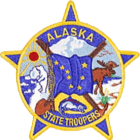 Patch of the Alaska State Troopers | |
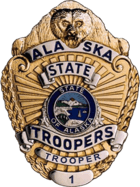 Badge of an Alaska state trooper | |
 Flag of the Alaska State Troopers | |
| Common name | Alaska State Troopers |
| Abbreviation | AST |
| Motto | "Loyalty, Integrity, Courage" |
| Agency overview | |
| Formed | 1967 |
| Preceding agencies |
|
| Employees | 653 commissioned members [1] |
| Jurisdictional structure | |
| Operations jurisdiction | Alaska, U.S. |
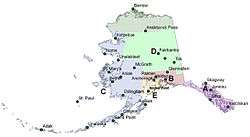 | |
| Alaska State Trooper Detachments | |
| Size | 663,268 square miles (1,717,900 km2) |
| Population | 736,732 (2014 est.)[2] |
| General nature | |
| Operational structure | |
| Headquarters | Anchorage, Alaska |
| Troopers | 379 |
| Civilians | 303 (as of 2013) |
| Agency executive |
|
| Parent agency | Alaska Department of Public Safety |
| Bureaus | 2 |
| Facilities | |
| Detachments | 5 |
| Website | |
| dps.state.ak.us/ast | |
Because Alaska has no counties, therefore no county police or sheriffs, in its constitution, the troopers also handle civil papers and mental health custody orders and serve as police throughout mostly all of rural Alaska. Alaska does have boroughs, which have some similarities but with lesser powers of lower-48 U.S. counties, but only the North Slope Borough police truly functions similarly to a lower-48 county police agency and thus relieves AST of a need to be the primary police agency in this particular region. Alaska troopers are the most geographically extended peace officers aside from federal officers in the USA. They have little, if any local backup; within the entire State of Alaska, only about 1,300 full-time sworn law enforcement officers patrol a state 1/5th the size of the entire lower-48 and other than troopers and state park rangers, the local officers remain in their communities except in extreme emergencies. This includes the only metropolitan police agency in Alaska, the Anchorage Police Department with almost 500 officers. The remaining officers are the over 300 Alaska troopers and smaller municipal agencies which have around 50 in towns like the state capital of Juneau or the second largest town in the state, Fairbanks. The remaining officers serve in small agencies with anywhere from one to ten officers on average.
The DPS is headed by a Commissioner appointed by the Governor. This person is actually a civilian administrator, though historically a career law enforcement officer and administrator. The Commissioner, if a sworn officer upon being appointed as such, may be appointed a "Special Alaska State Trooper" to maintain police powers. The Alaska State Troopers (AST) and Alaska Wildlife Troopers (AWT) are headed by ranking officers with the rank of Colonel.
History
The Alaska State Troopers trace their heritage back more than a century. Before its founding, law enforcement in Alaska was performed by a succession of federal agencies: the Army, Navy, and Revenue Cutter Service; the Customs Service and the Marshals Service – after a civil government was formed in 1884.
The need for law enforcement became critical in the late 19th century as gold was discovered in Alaska. Gold rush towns had crime rates per capita that dwarfed those of modern U.S. cities. Prostitution, gambling, murder, rape, robbery, arson, kidnapping, aggravated assault, and claim jumping incidents were rampant. Frightened citizens desperately cabled for help. As a result, scores of deputy marshals were deployed to Alaska. Some cities and towns began to charter police departments in the early 20th century. Deputy marshals continued to be the main force of law in rural Alaska until the advent of the troopers and many early-era officers of the agency were former deputy marshals.
There was no Alaska-wide police force until 1941, when the territorial legislature created the Alaska Highway Patrol. Territorial patrolmen only patrolled the main highways of Alaska, and did not visit remote areas or regions. They were commissioned to only enforce traffic laws. They were eventually deputized as special deputy marshals to fill this void in jurisdiction. The legislature refused to make them police officers until the agency was changed to Territorial Police and additional personnel were hired from among the marshals' ranks. The new agency became the Alaska Territorial Police in 1953, and changed its title to Alaska State Troopers in 1967.
Duties
The Division of Alaska State Troopers personnel are the general police arm of the agency. They are charged with statewide law enforcement, prevention of crime, pursuit and apprehension of offenders, service of civil and criminal process, prisoner transportation, central communications, and search and rescue. They perform traditional duties most associative with state police in lower-48 states.
The trooper division is divided into five lettered detachments, corresponding to geographic regions of the state, for general policing. The division also contains several bureaus: Alaska Bureau of Investigation (ABI), Alaska State Fire Marshal Office, Alaska Bureau of Alcohol and Drug Enforcement (ABADE), Alaska Bureau of Highway Patrol, and Alaska Bureau of Judicial Services. The detachments are charged with division responsibilities within their geographic areas. The bureaus are responsible for the statewide discharge of their specific duties and overall responsibilities. Both detachments and bureaus are responsible for ensuring efforts are made towards meeting the division's core missions as it relates to their respective enforcement programs, public education, training, fiscal planning, and implementation.
The Highway Patrol Bureau functions much like highway patrol agencies of the lower-48 states, with emphasis on major and fatal traffic collisions, speed enforcement, DUI enforcement, and preventative traffic patrol and enforcement, especially on areas like the Parks Highway near Denali National Park. These Troopers receive specialized training in DUI enforcement, traffic collision investigation, reconstruction, and speed enforcement.
ABI provides specialized investigative support to smaller agencies requesting help in cases and it provides detective services to all areas not served by local police. ABI investigators are specially selected and trained investigators who also assist in federal cases and receive specialized investigative and technical instruction throughout their careers.
State Fire Marshal personnel are referred to as deputy fire marshals. These deputies have full police powers. They investigate cause and origin of major fires involving significant monetary loss, loss of critical buildings, or any suspicious fire that results in death or serious injury. They also assist local agencies and authorities in fire cause and origin investigations. They also investigate explosions and often work with the United States Bureau of Alcohol, Tobacco, Firearms and Explosives (ATF). They receive specialized training from facilities such as the U.S. Fire Academy in Emmitsburg, Maryland.
ABADE personnel are assigned to investigate drug and vice offenses, such as drug manufacturing, smuggling, illegal gambling, prostitution, child sex exploitation and human trafficking. They often work on task forces and in undercover assignments throughout the state. They also work with local agencies and the U.S. Drug Enforcement Administration (DEA), Homeland Security Investigations (HSI) and US Postal Inspectors in mail smuggling cases. Particular emphasis in this area is applied to rural Alaska, where many communities have exercised local option laws to restrict or ban the sale or even possession of alcohol, leading to a prevalence of "bootleging".
Judicial Services officers are peace officers who perform duties traditionally associated with "bailiffs" in the lower-48 sheriff agencies: court facility security, transportation of prisoners, service of criminal and civil process, and protection of the Judiciary.
The State Scientific Crime Detection Lab: The lab, located in Anchorage is fully equipped to provide support and analysis of DNA, blood drug and alcohol blood and breath test screening, fingerprint examination, foot and tire impression analysis, firearm analysis, tool mark analysis, drug exam, fire and explosion trace evidence analysis, UV exam and technology analytical services. The lab serves all of Alaska with certified, highly trained technicians and forensic examiners. AK DPS crime lab personnel are considered among the most proficient examiners in the world to examine. They provide investigative training to police on these techniques.
DPS Academy: The academy in Sitka, located across from the now-closed Sheldon Jackson College is the main police training academy of the state. With the guidelines of the Alaska Police Standards Council (APSC), the academy trains trooper and DPS officers in basic training, in addition to also training local law enforcement officers. DPS trooper personnel remain at the academy for additional "trooper-specific" training once the basic Alaska Law Enforcement Training (ALET) class graduates. The academy is rigorous and paramilitary. The other public academy in the state, located at the former University Park Elementary School on the University of Alaska Fairbanks campus and run by the UAF Community and Technical College, is not affiliated with DPS but is approved for APSC certification. The Municipality of Anchorage also has an internal ALET academy for its own officers and it occasionally offers in-service classes to other agency personnel. The DPS Academy instructors are given the rank and title of "corporal", the only place in the AST where this rank is used. This assignment can be a stepping stone to promotion and only the most elite of troopers are made training corporals, based on leadership, ability to train, fitness, aptitude, shooting ability and general appearance.
The Division of Wildlife Troopers is charged also with statewide law enforcement, the same as the State Trooper Division. This division was created in the mid 1970s upon the Alaska Department of Fish and Game (ADF&G) relinquishing game wardens from its staff and making them consolidated with the AST as full-fledged troopers. The wildlife division is a fully integrated part of AST and while these troopers perform duties most common with that of game wardens and wildlife conservation or marine patrol officers in the lower-48 states, they do however, make arrests for any crimes and routinely act in general law enforcement capacities. AWT Troopers enforce traffic laws and respond to calls for police services as needed. They enforce traffic laws regarding drunken driving, RADAR-speeding enforcement and reckless driving on remote or US Forest Service highways and roads. AWT Troopers are nicknamed "brown shirts" by Alaskans because though their uniforms are almost identical to regular troopers, they also have a slightly different patch from blue shirts on the brown shirt. The division has a rank structure of its own the same as the blue shirts from Trooper to Colonel. The AWT Troopers operate more in boats and aircraft and many troopers are pilots. AWT operates statewide. They have several large seagoing ships with civilian crews and sworn troopers on board for enforcement actions in commercial fishing enforcement and search and rescue. AWT has a core mission of protecting natural resources through hunting and fishing law enforcement. They also aggressively enforce boating safety laws and investigate boating accidents. AWT Troopers enforce federal laws by memorandums of Agreement (MOA) with the US government regarding endangered species, the migratory bird treaty laws and the Lacey Act among others. AWT regularly works with and assists federal law enforcement agency personnel such as U.S. Marine Fisheries Service, U.S. Coast Guard, U.S. Bureau of Land Management, U.S. Forest Service, U.S. Park Service and the US Fish and Wildlife Service in conservation law enforcement.
Alaska troopers routinely respond to emergencies alone or with only one other trooper as backup. Additional backup can be hours away, or even days away if weather is severe enough. This requires AST troopers to be independent thinking and self-sufficient. Over 50 troopers, including elements of the SWAT teams from Anchorage and Fairbanks regions and the Juneau Police Department SWAT team all deployed to the southeastern community of Hoonah on August 29, 2010 when two local officers of the Hoonah city police were shot and killed in a rifle ambush shortly before midnight on the 28th. Only the chief of police and one officer remained alive and a local trooper who lived in Hoonah assisted alone for approximately 8 hours. Adverse weather prevented AST small planes and boats from deploying to ferry personnel and equipment, so the US Coast Guard cutter Liberty transported the personnel to Hoonah. The suspect was eventually apprehended two days later when he was tear gassed.
Department of Public Safety rank structure
| Title | Insignia |
|---|---|
| Commissioner | |
| Deputy Commissioner |
Rank structure
| Title | Insignia |
|---|---|
| Colonel | |
| Major | |
| Captain | |
| Lieutenant | |
| Sergeant | |
| Corporal | |
| Trooper | No Insignia |
Field organization
Alaska State Troopers
The Alaska State Troopers consists of five regional detachments controlling 43 State Trooper Posts.
- A Detachment has its headquarters in Ketchikan with posts in Haines, Juneau, Klawock, Ketchikan, Petersburg
- B Detachment has its headquarters in Palmer with posts in Glennallen, Wasilla
- C Detachment has its headquarters in Anchorage with posts in Anchorage, Aniak, Bethel, Dillingham, Emmonak, Iliamna, King Salmon, Kodiak, Kotzebue, McGrath, Nome, Saint Mary's, Selawik, Unalakleet
- D Detachment has its headquarters in Fairbanks with posts in Barrow, Cantwell, Delta Junction, Fairbanks, Galena, Healy, Nenana, Northway, Tok
- E Detachment has its headquarters in Soldotna with posts in Anchor Point, Cooper Landing, Girdwood, Ninilchik, Seward, Soldotna
Alaska Highway Patrol
The Alaska Bureau of Highway Patrol's (ABHP) consists of three troopers on Seward Highway after budget cuts forced reductions.[3] Responsibilities include traffic enforcement, highway safety education, and investigating crashes that cause injuries or deaths on a statewide basis with an emphasis on impaired driving enforcement. Additionally the Highway Patrol responds to enforcement and investigative requests by other agencies.
Alaska Wildlife Troopers
Wildlife Troopers are divided into two geographical detachments controlling 35 Wildlife Trooper Posts
Northern Detachment has its headquarters in Palmer and posts in Anchorage, Glennallen, Mat-Su West, Talkeetna, Soldotna, Anchor Point, Cordova, Girdwood, Seward, Valdez, Fairbanks, Aniak, Bethel, Cantwell, Coldfoot, Delta Junction, Galena, Kotzebue, McGrath, Nome, and Tok
Southern Detachment has its headquarters in Anchorage and posts in Kodiak, Dillingham, King Salmon, Dutch Harbor, Port Alsworth, Juneau, Haines, Hoonah, Ketchikan, Prince of Wales, Petersburg, Sitka, Wrangell, and Yakutat.
Alaska Bureau of Investigations
The Alaska Bureau of Investigations (ABI) is responsible for coordinating and conducting major criminal investigations within Alaska State Troopers jurisdiction to include homicides, sexual assaults, polygraph examinations, fraud, forgery, computer and internet crimes, surveillance, missing persons and lengthier property crimes investigations. ABI headquarters is located in Anchorage with posts in Anchorage, Bethel, Dillingham, Fairbanks, Juneau, Ketchikan, Kotzebue, Nome, Palmer, Soldotna, Wasilla. The ABI consists of seven Investigation Units are; Major Crimes, Technical Crimes, Property Crimes, Financial Crimes, Child Abuse Investigations, Cold Case Investigations, and Statewide Drug Enforcement.
Special Emergency Reaction Team
The Alaska State Trooper Special Emergency Reaction Team (SERT) responds to high-risk incidents including hostage situations, warrant executions, and terrorist incidents. SERT Teams are located in the urban posts of Fairbanks, Palmer, and Soldotna. SERT is an added, voluntary assignment for specially-qualified Troopers in addition to their other duties. SERT Troopers train regularly and remain on call after hours for emergencies.
Search and Rescue
Alaska State Troopers organize Search and Rescue resources from multiple agencies and provide assets when needed.
Mission
The Alaska State Troopers' six core missions in meeting these responsibilities are:
- Reduce the impact of drugs and alcohol on communities through statewide drug and alcohol enforcement;
- Provide professional, effective and efficient statewide major crime investigations;
- Provide prompt professional proactive and reactive rural public safety services;
- Protect Alaska's fish and wildlife resources through enforcement programs;
- Enhance public safety through highway traffic enforcement and education;
- Provide quality statewide training.[4]
National security and post-9/11 roles
The Alaska State Troopers trace special duties back to the onset of World War II, when Territorial Highway Patrolmen watched for Japanese invaders and saboteurs by guarding and patrolling Alaska seaports, railroad tracks, airports, military posts and other important facilities. This was especially critical following the invasion of Alaska by the Japanese. Territorial patrolmen also assisted the military by arresting deserters and AWOLS from the armed forces.
After the 9-11 attacks, Alaska State Troopers were recognized by the US government as being in an extremely valuable and unique position and thus a critical asset to national security. Alaska is by distance close to a nuclear-armed nation—North Korea—and even closer to the People's Republic of China. Alaska actually borders Russia and these factors have caused AST to have a historic role in national security. AST and ABI in particular, assist the FBI, US Department of Homeland Security and other federal and military agencies in protecting the US from terrorist activity. ABI assisted the FBI in 2009 in a high-profile preemptive terrorism investigation that resulted in the arrest of a man and woman who were radical Islamist converts and who were planning terrorist attacks from King Salmon, AK. Trooper aircraft historically kept a watchful eye for intrusions into US airspace by Soviet aircraft during the Cold War. As a state entity, AST pilots and aviation assets continue to watch over Alaskan airspace to date in conjunction with the Alaska Wing of the Civil Air Patrol (CAP), in providing protection from threats to national security as it assists the US Coast Guard, US Air Force and US Army air operations as requested.
The Alaska Department of Public Safety Training Academy
The Alaska State Trooper DPS Academy is located in the Sawmill Creek area of Sitka, Alaska. With recent television exposure on the National Geographic reality television series "Alaska State Troopers", the DPS Academy is known worldwide as a premier police training institution, as it trains recruits of the Alaska State Troopers, State fire marshals, Village Public Safety Officers (VPSO's) as well as other law enforcement personnel, including Alaska's several state universities campus police departments, state parks law enforcement rangers, state airport police officers and various municipal police officers. The facility has dorms, classrooms, exhibits, a gym and a nearby firing range. The academy was built because of the traditional association and shared use of facilities of the campus of the adjacent and now defunct Sheldon Jackson College.
The academy is technically known as the Alaska Department of Public Safety Training Academy (also the DPS Academy). The academy staff provides state-of-the art basic and in-service training to recruits, law enforcement officers, peace officers and public safety personnel from across Alaska. The rigorous nature of the basic ALET training course offered at the academy is a challenge to students who are referred to as "recruits." Basic classes often have members quit due to the round-the-clock physical and mental rigors of the paramilitary training course.
In keeping with the historically close and unique working relationship between Alaska civil law enforcement and the military law enforcement arms of the U.S. Armed Forces, law enforcement personnel of the U.S. Army Military Police, U.S. Air Force Security Forces and U.S. Coast Guard Maritime Law Enforcement Service are picked by their respective commands to attend slots in the DPS Academy that are reserved for the military services. Such training is a special career advancement opportunity for military law enforcement personnel from various Commands in Alaska and being selected to attend the AK DPS Academy is a highly competitive and sought-after opportunity that is considered to be a career highlight and honor. Only the most elite of military law enforcement personnel are selected to attend.
Canadian law enforcement officers, most notably the Royal Canadian Mounted Police (RCMP) often attend special training courses and firearms competitions at the Academy. The RCMP is an official "friendship" agency with the AST and long and historic ties in working with Troopers.
In-service training is offered to Troopers annually and additional specialized course are offered to law enforcement, public safety and military personnel at various times each year.
The academy offers two full Alaska Law Enforcement Training (ALET) courses a year and one "mini" academy of 80 hours/2 weeks for former AK and out-of-state officers who wish to reenter or enter Alaska law enforcement. The full 15-week program gives state trooper and municipal officer recruits the basic academy certificate required by the Alaska Police Standards Council (APSC) as does the mini-academy for completion of credentialing for approved partially certified, retired, former and out-of-state officers.
The current Academy officially opened its doors in October 1974, though a number of basic classes had been offered at Sheldon Jackson College as far back as 1969, with a two-week basic course offered for new troopers.
Several additions to the Academy facility have been made since then, including a new wing with dorm rooms and separate restrooms and shower facilities for females. A weight training facility and multipurpose-recreation room was added in 2001.
In 2004 a completely new and state-of-the art firearms training range was built in cooperation with the City and Borough of Sitka about 7 miles (11 km) from the academy's main facility. This range is also used by Sitka Police and several federal law enforcement agencies with offices in the region. The facility has a complete indoor classroom and long-range lanes of firing points, for both rifles, shotguns and pistols. There is a qualification and stress course set up, with dim lighting capabilities for low-light and nighttime firing, among other features.
The Academy offers a small museum, showing displays of historic weapons, equipment and uniforms, along with other exhibits related to the history and training of AK Troopers and their predecessor officers and agencies through the history of Alaska, as both a Territory and as the 49th State.
Village Public Safety Officer Program
The Alaska State Troopers also manage the Village Public Safety Officer program, which provides a peace officer presence in remote communities, usually Native villages that have no police departments and are too small for a trooper post. VPSOs are state trained peace officers, and as of July 2014 are fully credentialed Alaska police officers. They carried no firearms from the start of the program in the mid-1970s until the Alaska legislature authorized arming the officers and making them fully empowered peace officers as of July 2014. This legal change was in response to the violent assaults, shootings and even two murders of VPSOs in the line-of-duty on differing occasions. The DPS Academy is tasked to train and certify VPSOs with firearms. In addition, VPSOs also carry all other typical tools of a peace officer, such as Kevlar bullet resistant body armor, TASER electronic control weapon, pepper spray, and baton. The VPSO 9-week basic training course at the DPS Academy mirrors several aspects of the ALET program except that VPSOs do not receive basic emergency vehicle operation course (EVOC). If a VPSO should later opt to join a police department after completion of VPSO training, they would not be required to attend the full DPS Law Enforcement Training Program.
VPSOs are employed by local Native Corporations and supervised by designated area Troopers. VPSOs carry out only basic police tasks such as emergency call response, juvenile offense investigations, protective custody holds of inebriates, assistance to social workers and medical providers, crime scene preservation, issuance of citations for misdemeanor and non-criminal violation offenses, misdemeanor arrests and detention of felony suspects for surrender to troopers, wildlife protection through the Division of Fish and Wildlife Enforcement, engage in search and rescue of missing persons and perform services usually performed by county sheriff's departments in other states, such as prisoner transport. VPSOs usually also receive Alaska Firefighter-I training and either Alaska Emergency Medical Technician-I (EMT-I) or Alaska Emergency Trauma Technician (ETT) in addition to the basic training.[5]
The Village Public Safety Officer Program began in the late 1970s as a means of providing rural Alaskan communities with needed public safety services at the local level. The program was created to reduce the loss of life due to fires, drowning, lost person, and the lack of immediate emergency medical assistance in rural communities. The Village Public Safety Officer Program was designed to train and employ individuals residing in the village as first responders to public safety emergencies such as search and rescue, fire protection, emergency medical assistance, crime prevention and basic law enforcement. Recent pay raises, statutory changes for firearms armed VPSOs and other areas of expanded training have improved the retention and recruitment of VPSOs.[5]
Fallen officers
There have been 16 Alaska State Troopers and 2 K9s killed since its beginning in 1948. [6]
Equipment
Firearms
| Name | Type | Caliber | Origin | Notes |
|---|---|---|---|---|
| Glock 22 | Pistol | .40 S&W | Standard Issue and is Gen 4 | |
| Remington 870 | Shotgun | 12 Gauge | ||
| Colt AR-15 | Patrol Rifle | 5.56mm | ||
| Heckler & Koch MP5 | Sub-Machine Gun | .40 S&W | Special Emergency Reaction Team only | |
| Remington 700 | Sniper Rifle | .308 Winchester | Special Emergency Reaction Team only | |
Smith and Wesson M&P model 10 .308 Current issue to AWT
Vehicles
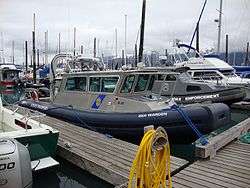
The Alaska State Troopers operate the following vehicles:
- Chevy Express Van

- Chevrolet Impala

- Chevy pickup truck

- Dodge Charger

- Ford Crown Victoria Police Interceptor

- Ford Police Interceptor Sedan

- Ford Police Interceptor Utility

- Ford Expedition

- Ford F-250

- Ford F-150

- Lenco BearCat

Aircraft
- Beechcraft Super King Air

- Cessna 185

- Cessna 208

- Eurocopter AS350

- Piper PA-18

- Robinson R44

Previous Issued Sidearms
- Smith & Wesson Model 4006 .40 S&W- replaced by the Glock Model 22 .40 S&W
- Smith & Wesson Model 686 .357 magnum- replaced by the Smith & Wesson Model 4006
- Smith & Wesson Model 66 .357 magnum- replaced by the Smith & Wesson Model 686
- Smith & Wesson Model 19 .357 magnum- replaced by the Smith & Wesson Model 66
Museum
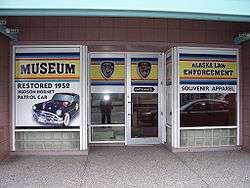
The Alaska Law Enforcement Museum is a small museum located at 245 W. 5th Avenue, Suite 113 across from the 5th Avenue Mall in downtown Anchorage, operated by the Fraternal Order of Alaska State Troopers. The museum commemorates the Alaska State Troopers and features a variety of historical memorabilia, including a restored 1952 Hudson Hornet patrol car.
In popular culture
Clint Walker starred as the title character in Kodiak, a short-lived TV series that ran on ABC in 1974. Walker played "Kodiak" McKay, an officer in what was called, in this series, the "Alaska State Patrol."
The National Geographic hit television reality series Alaska State Troopers accompanies troopers throughout the state as they perform their various duties. The show depicts firsthand, the short-handed troopers in their harsh and dangerous duties of the AST. Two troopers who regularly appeared on the show, Sergeant Patrick "Scott" Johnson and Trooper Gabriel Rich were both shot and murdered in the line of duty, while investigating a weapons complaint in the small rural Arctic town of Tanana (Yukon River) in 2014. The show has been very positively received worldwide and is credited with a peak in interest by people wanting to serve as an Alaska Trooper or other peace officer in Alaska.
Alaska State Troopers appear prominently and regularly on other TV reality shows such as Ice Road Truckers, Tougher in Alaska and Deadliest Catch. They were also featured occasionally on the show Northern Exposure as the Alaska State Police.
Alaska State Troopers were highly visible during the 2008 Presidential campaign, providing security detail supplemental personnel to the US Secret Service while protecting former Alaska Governor and Republican Vice presidential candidate Sarah Palin.
See also
| Wikimedia Commons has media related to Alaska State Troopers. |
- Alaska State Troopers (TV series)
- Alaska Public Safety Commissioner dismissal
- Highway Patrol
- Jean Frances Howard, who was AST's first female sworn officer and was inducted into the Alaska Women's Hall of Fame by virtue of that accomplishment of being an State Trooper
- List of law enforcement agencies in Alaska
- State Patrol
- State Police (United States)
References
- "Home - Recruit - AST - Alaska Department of Public Safety". dps.alaska.gov.
- "State & County QuickFacts - Alaska". U.S. Census Bureau. Archived from the original on 2010-05-27.
- "Walker proposes to reassign Alaska highway patrol troopers". Alaska Dispatch News.
- "Home - AST - Alaska Department of Public Safety". dps.alaska.gov.
- "Home - VPSO - AST - Alaska Department of Public Safety". dps.alaska.gov.
- "Alaska State Troopers, AK".
- Alaska State Troopers purchase three Lenco BearCats - Armyrecognition.com, March 22, 2013